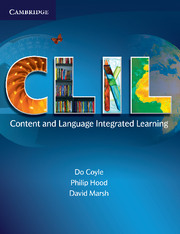For those out there who like research…you will enjoy all the work done by Neus Lorenzo. Check it out with your own eyes!

Category Archives: RESOURCES FOR TEACHERS
New CLIL book by CUP (Available from March 2010)
CLIL (Content and Language Integrated Learning) has emerged since the millennium as a major trend in education. Written by Do Coyle, Philip Hood and David Marsh and drawing on their experience of CLIL in secondary schools, primary schools and English language schools across Europe, this book gives a comprehensive overview of CLIL. It summarises the theory which underpins the teaching of a content subject through another language and discusses its practical application, outlining the key directions for the development of research and practice. This book acknowledges the uncertainty many teachers feel about CLIL, because of the requirement for both language and subject knowledge, while providing theoretical and practical routes towards successful practice for all.
(CUP) http://cambridge.org/elt/elt_projectpage.asp?id=2501133
The Contribution of Multilingualism to Creativity – Science Report published by the European Commission, October 2009
This macro study examined scientific evidence which reveals benefits of multilingualism for the brain and subsequent human performance.
Multilingualism is the ability of societies, groups and Uncovering CLIL Quality by CLIL Practitioners individuals to engage, on a regular basis, with more
Evidencing CLIL Quality by CLIL Researchers than one language in their day-to-day lives.
New CCN Newsletter-October 2009
I Jornades sobre la metodologia AICLE-CLIL, EMILE 6-7 NOVEMBER 2009
New great CLIL conference in Barcelona:
Les Jornades sobre la metodologia AICLE-CLIL volen presentar la situació actual de la pràctica docent, formació de lprofessorat i recerca en l’aprenentatge integrat de continguts i llengua estrangera al nostre país, així com fomentar la col·laboració entre el professorat de matèries no lingüístiques i el de llengua estrangera.
També pretenen animar tots aquells professors i professores que compleixin els requisits a impartir la seva matèria en llengua estrangera.
Aquest tema es tractarà a través de dues conferències i una taula rodona, que ens permetran contrastar el que estem fent al nostre país amb el que s’està fent en països del nostre voltant. També comptarem amb un ampli ventall de tallers pràctics presentats per professors i professores de diferents matèries que ja han incorporat aquesta metodologia en les seves aules.
Coordinació: Rosa Pérez Bohigas i Imma Ros
MORE INFO: http://www.cdl.cat/actividades/jornada
CLIL-NETWORK-Interesting website
CLIL-NETWORK is a collaboration network for immersion teachers and teachers who teach in a foreign language in Finland. The National Centre for Professional Development in Education put the network together in 2005 as part of their education and development project. The CLIL-NETWORK project is funded by the National Board of Education and will continue until the end of 2007. The network is also supported by Suvikyky (Finnish Association of CLIL and Immersion Education) and the city of Tampere. The contents of this website are the products of teachers and other experts who have taken part in this project.
On the emergence of L2 oracy in bilingual education: una tesis
La gent del bloc http://deestranjis.blogspot.com/ escriuen el següent article sobre CLIL; val la pena llegir-lo…
El pasado lunes tuve la suerte de formar parte del tribunal que evaluó la tesis de Pat F. Moore, titulada ” On the emergence of L2 oracy in bilingual education: a comparative analysis of CLILand mainstream learner talk” y dirigida por el Dr. Francisco Lorenzo, de la Universidad Pablo de Olavide. Me gustaría contaros cuáles son las conclusiones de este trabajo de investigación de tres años de duración realizado por una investigadora llena de ilusión y de experiencia (además de una experta en evaluación de la comunicación oral y hablante de varias lenguas)...
(click en la imatge per seguir llegint)
More on i-board
BRAND NEW CLIL UNITS ADDED!!
Drama in Maths – Drama for Learning. From teachers.tv
How one teacher uses the Drama for Learning and Creativity initiative to incorporate drama into her maths lessons.
D4LC, an initiative pioneered by Patrice Baldwin of Norfolk County Council Children’s Services. She explains how she uses it to train teachers to improve their drama techniques and deliver drama lessons across all areas of the curriculum.
Here, the focus is on a lesson given by Terri English at Great Hockham School in Norfolk. It follows her use of “Teacher In Role” as a creative device to make maths lessons more engaging for her pupils, stimulating the creative side of their brains.












